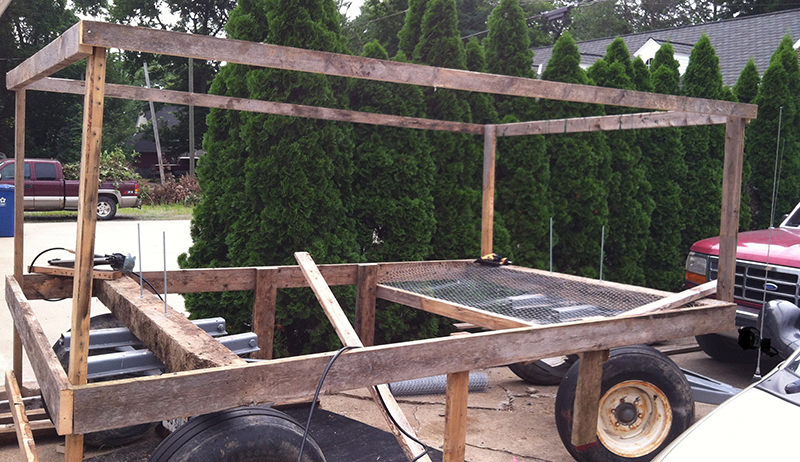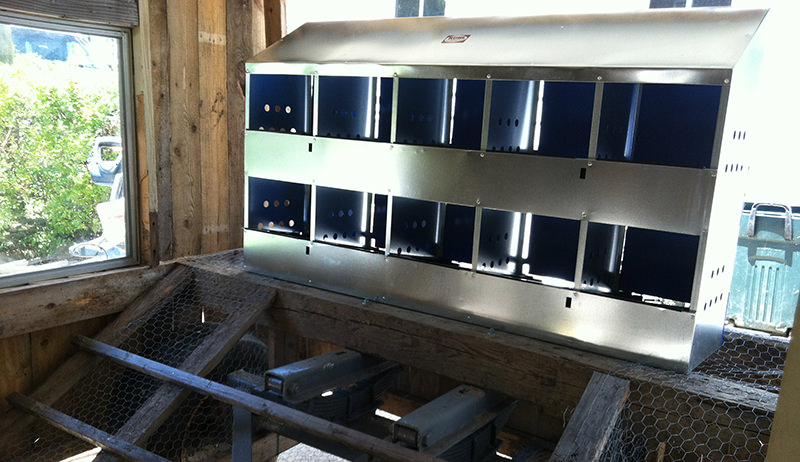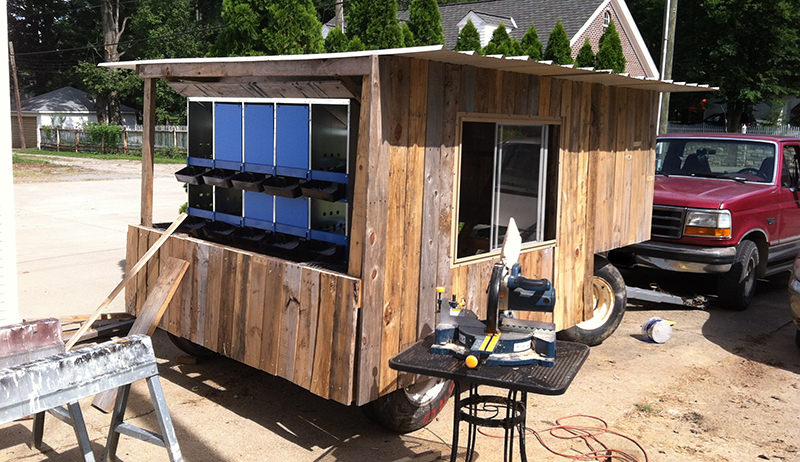
When my family decided to start raising chickens, the thought of having one of those wasteland areas inside a chicken coop didn’t appeal to any of us. You know what I’m talking about—the hard, compacted, moon-like surface created by the chicken manure that isn’t healthy for chickens or humans. We also recognized the beneficial attributes of chicken manure: It’s high in nitrogen, phosphorus and potassium, but it needs to be used in moderation, even though the chickens just don’t seem to create manure in moderation. We clearly needed a mobile chicken coop that could traverse the rough pasture area on our land.
The following instructions detail how we solved this problem by building a mobile chicken coop using a set of farm running gear. I chose running gear as a base for the egg mobile because of the sturdy, large frame and the large tires that wouldn’t get bogged down in ruts on the property or in wet, muddy areas. Most farm service companies mount anhydrous tanks to these for applying nitrogen fertilizers to fields. They typically replace some of their fleet each year, so you should be able to purchase a used set at a very reasonable price.
What You’ll Need:
- 2 8-foot 6x6s
- 16 8-foot 2x4s
- 1 10-foot 2×4, cut in half
- 3 12-foot 2x4s
- 2 8-foot 2x6s
- 2 12-foot 2x6s
- 5 10-by-3-foot sheets of metal roofing
- 80 8-foot 1x6s
- chicken wire
- nest box
- chicken door
- storm window
- running gear for a wagon
- 4 pieces of threaded rods
- 3-inch screws
- 1½-inch nails
- staple gun and 5/8 staples
Step 1

On top of the running gear, I built a box wagon. First, I mounted one 8-foot 6×6 over each set of wheels in the front and the back of the running gear. Using the existing holes on the running gear, I simply used four threaded rods to hold them in place.
Step 2

Next, I began to build the frame. I used two 12-foot 2x6s to extend the sides beyond the wheels and two 8-foot 2x6s for the ends of the platform, and mounted them with 3-inch screws. To complete the box, I attached an 8-foot 2×4 to the inside of each corner of the frame using 3-inch screws. The height of your wagon will dictate your clearance above the ground. Allow yourself at least a foot of clearance from the ground for rough terrain. To complete the top of the frame, I used a 12-foot 2×4 on each side and an 8-foot 2×4 on the front and the back, attaching them with 3-inch screws.
Step 3

Because top of the coop is level all the way around, you may deem it necessary at this point to create some slope for your roof to keep it from holding water. I figured that my pasture isn’t level, meaning the egg mobile would never sit on level ground, so I was OK with building a flat roof. I added five 8-foot 2x4s every 2 feet along the top to support the metal roofing (see step 10).
Step 4
Creating the bottom of the coop was a little more complicated because we had to accommodate the swing of the front wheels. I placed an 8-foot 2×4 perpendicular to the long sides (the 2x6s) of the coop, 4 feet from the front of the coop, and attached it with 3-inch screws. I cut one 12-foot 2×4 into four 3-foot pieces, and then attached a 3-foot 2×4 to each long side against the 2×4 at the 4-foot mark. I measured 2 feet from each 3-foot 2×4 toward the rear of the coop, and attached another 3-foot 2×4 to the long sides of the coop. Connect these 3-foot sections to the back of the wagon using an 8-foot 2×4 on each side to ground edges of the 3-foot 2x4s together. This will give you a nice bottom nailer for the sides of your coop. Connect the bottom edges of the front 3-foot 2x4s with an 8-foot 2×4. The bottom of the egg mobile should now be 8 feet square.
Step 5
We installed an easy-access door at the bottom of the coop for the chickens, centered between the 3-foot 2x4s. I used the Pullet-Shut Automatic Chicken Door, which measures 14⅜ inches wide by 18⅛ inches tall.
Step 6
Next we put blocking around the back tires so that chicken predators couldn’t enter the coop there. This required an 8-foot 2×4 to be placed across the bottom 8-by-8-foot square, with 2 feet between it and the 2×4 at the front. I attached a 5-foot 2×4 to the bottom 2×4, 6 feet from the rear of the coop—it should be touching each long side of the egg mobile.
Step 7
With a staple gun, we attached chicken wire to the bottom of the coop as the flooring—this allows the manure to fall to the ground instead of collecting in the coop. This works best if you attach from the inside, not the bottom of the egg mobile.
Step 8
Depending on how you position your nest box, you will either need to create a human door or a door that allows you to access the nest box from the outside of the coop. Because we installed rear roll-out nest boxes, we placed them near the back of the coop and built a hinged door that we could open to get the eggs.
Step 9

Build adequate roosts for the chickens and install a nest box. We purchased a Kuhl 10 Hole Rear Roll-out Nest box and mounted it directly over the rear 6×6. When a chicken stands up after laying an egg, the egg rolls down the gentle slope to a catch tray behind each nest box. This keeps the eggs safe from other chickens, eliminates broodiness and leaves the nest box ready for the next chicken.
Step 10

We covered the roof with five 10-foot sheets of metal roofing panels. This provided a little overhang on each side of the coop and gave us plenty of overlap on each sheet.
Step 11
The final step is to cover the sides of the egg mobile with your choice of siding material. For our egg mobile we used 80 8-foot 1x6s, which all came from recycled pallets. We installed them by disassembling the pallets and fitting them around the coop using 1½-inch nails.
After the siding was in place, we installed a chicken door and a way to check on the chickens or enter the egg mobile if you need to do so. We used an old storm window on each side of the coop. Because this unit moves around our property, we used a solar-powered chicken door by Pullet-Shut Chicken Doors to eliminate the need to manually operate the door in the morning or evening.




